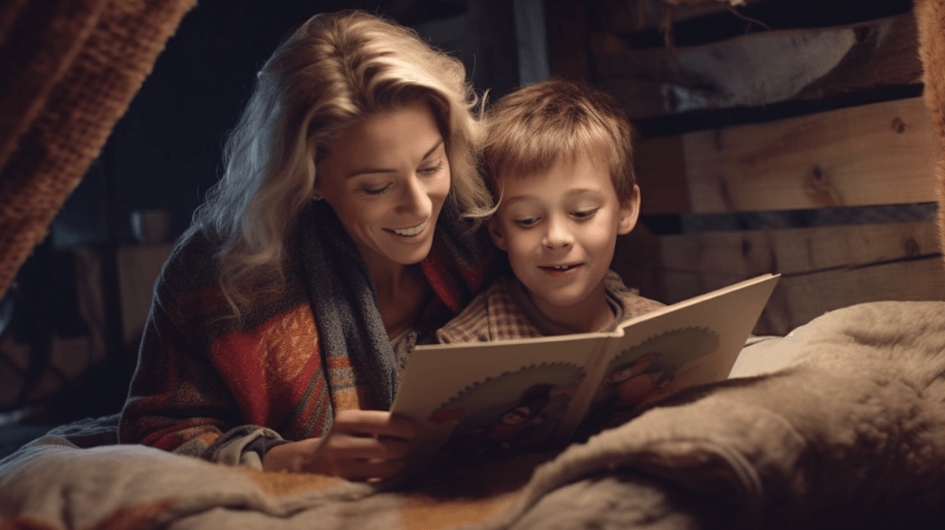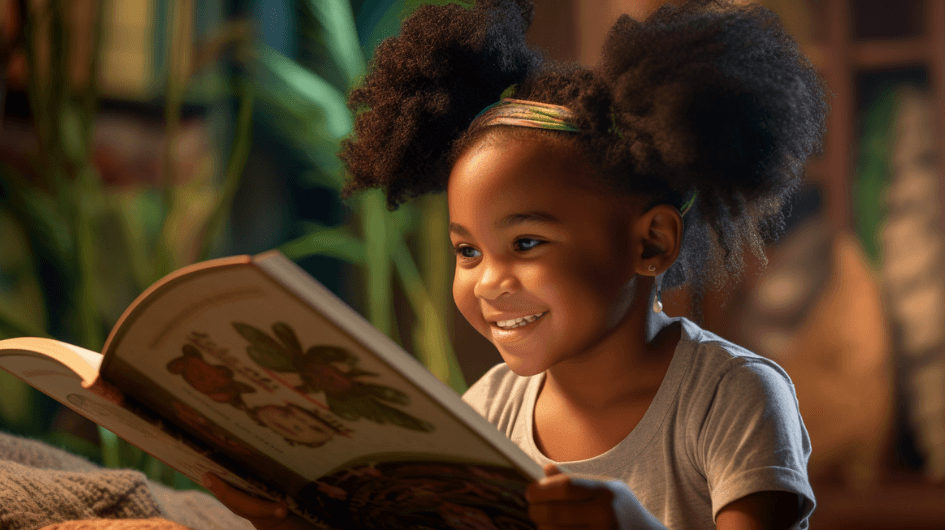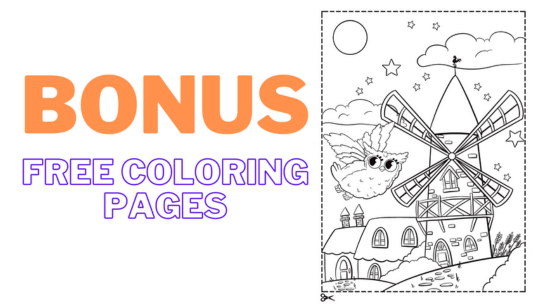
How to Choose the Right Books for Your Child
Choose the right books for your child and foster a love for reading that can have a profound impact on their development, imagination, and lifelong learning.

Mindfulness has gained significant attention as a practice that promotes well-being and mental balance. Mindfulness involves being fully present in the moment and paying attention to thoughts, feelings, and sensations without judgment. While mindfulness is often associated with meditation and yoga, there are various other ways to cultivate mindfulness, connect with your child, and one such method is reading.
Integrating mindful reading into your daily routines can create meaningful and enriching experiences that promote emotional connection, relaxation, and self-reflection. Whether it’s a cozy bedtime story or a shared exploration of new worlds through books, mindful reading offers a unique opportunity to foster mindfulness, strengthen the parent-child bond, and nurture a lifelong love for reading.
Mindfulness is when you are fully present and aware of the present moment, without judgment or attachment to thoughts or emotions. It involves intentionally paying attention to one’s thoughts, feelings, bodily sensations, and environment.
Mindfulness roots come from ancient contemplative practices, particularly those in Buddhist traditions. However, it has been adapted and integrated into various secular contexts today. At its core, mindfulness involves:
Mindfulness invites us to anchor our attention in the present rather than dwelling on the past or worrying about the future.
Mindfulness encourages observing our experiences with non-judgment, acceptance, and curiosity rather than getting caught up in evaluation or criticism.
Mindfulness involves being open and accepting of whatever arises in our awareness, including thoughts, emotions, and sensations, without trying to change or control them.
Mindfulness practices have been extensively studied and shown to offer numerous benefits for both children and adults, including:
Mindfulness helps individuals manage stress and cultivate resilience by bringing awareness to their reactions and adopting a more compassionate response.
Mindfulness enhances emotional awareness, allowing children to recognize and navigate their emotions.
Training attention and redirecting it to the present moment, mindfulness improves concentration and cognitive performance.
Mindfulness promotes self-reflection and a deeper understanding of one’s thoughts, emotions, and behaviors, leading to personal growth and self-compassion.
Mindfulness cultivates an ability to cope with challenges and setbacks, fostering resilience and adaptability.
Regular mindfulness practice has been linked to increased well-being, positive mood, and overall life satisfaction.
Mindfulness can significantly enhance the parent-child connection. Mindful parenting involves bringing mindfulness principles into everyday interactions. It promotes effective communication and nurturing a loving and supportive relationship with your child.
By understanding the principles and benefits of mindfulness, we can explore how reading can be infused with mindfulness techniques to create a rich and meaningful experience for both parent and child.
Reading has a unique power to cultivate mindfulness and bring us into the present moment. When we engage in mindful reading, we immerse ourselves in the words, stories, and characters, allowing us to experience a deep sense of presence and connection.
Reading activates our senses and invites us to be fully present in the experience. When we touch the pages and hear their sound – we stimulate our tactile and auditory senses. Descriptive language and vivid imagery of books stimulate our imagination and visual senses, creating a rich sensory experience.
Mindful reading requires focused attention and concentration. Attention to the words, sentences, and storyline allows children to fully immerse themselves in the narrative. This focused engagement helps calm the mind and reduces distractions, promoting a state of flow and deep absorption.
Finding moments of stillness can be challenging. Reading provides a sanctuary for quiet reflection and introspection. When we read, we can temporarily disconnect from external distractions and immerse ourselves in the world of the book. This respite from constant stimulation allows for a sense of calm and inner stillness.
Reading encourages children to observe and notice the nuances within the story. They pay attention to character traits, emotions, and the narrative. This practice of observation without judgment mirrors the principles of mindfulness, where we cultivate an open and non-judgmental awareness of our experiences.
Books often evoke a range of emotions in children. By immersing ourselves in stories, we connect with characters’ experiences, challenges, and triumphs, fostering empathy and emotional resonance. This emotional connection invites us to be present with our feelings, further deepening the mindfulness experience.
Reading invites children to reflect on the themes, messages, and lessons inside the story. As we contemplate the ideas presented in the book, we gain insights into our lives, values, and beliefs. This reflective process encourages self-inquiry and introspection, supporting personal growth and self-awareness.
Practicing mindful reading with your child can deepen your connection, enhance their engagement with the book, and promote mindfulness skills. Here are some techniques to incorporate mindfulness into your reading sessions:
Before the reading session, take a moment to get focused. Start by letting go of distractions and bringing attention to the here and now. Take a few deep breaths together.
Encourage your child to notice the sensory aspects of the book. Guide them to touch the pages, feel the texture, and listen to the sound of turning pages. Explore the illustrations and describe the colors, shapes, and details. By engaging the senses, you enhance the sensory experience of reading and bring attention to the present moment.
While reading, encourage your child to listen attentively to the words and the rhythm of your voice. Help them notice the tone, emotions, and nuances in the story. Focusing on listening, you and your child can cultivate deep presence and enhance the connection between the words and the meaning behind them.
Throughout the reading session, take mindful pauses to reflect on the story. Pause after significant events, ask open-ended questions, and encourage your child to share their thoughts and feelings. Use these pauses as opportunities for both of you to connect and engage in meaningful conversations related to the book.
As you read, help your child identify and express the emotions brought up by the story. Help them notice how the characters feel and relate it to their experiences. Validate their emotions and create a safe space for them to explore and discuss their feelings. This practice cultivates emotional awareness and empathy.
Integrate mindful breathing exercises into your reading sessions. Take occasional breaks to focus on deep breathing, inhaling slowly and exhaling fully. This simple practice helps you and your child regulate emotions, reduce stress, and enhance your ability to stay present during the reading experience.
After finishing a book or a reading session, take a moment to express gratitude for the experience. Talk about what you appreciated, what you learned, or how the story made you feel. Gratitude cultivates a positive mindset and deepens the connection with the reading experience.
Engaging in mindful reading activities can create meaningful connections between you and your child while fostering mindfulness skills. Here are some activities to try:
Instead of reading a book, take turns creating a story together. Start with a simple prompt or theme and let your imaginations run wild. As you take turns, encourage each other to use descriptive language, evoke emotions, and engage the senses. This activity promotes creativity and mindfulness and strengthens the bond between you and your child.
Choose a book with beautiful illustrations or captivating visuals. Before reading, spend a few moments silently observing the pictures together. Encourage your child to notice the details, colors, and emotions shown in the illustrations. As you read the story, pause occasionally and discuss the visual elements mindfully.
Once you complete a book or a reading session, participate in a mindful conversation with your child. Aid them to express their thoughts, emotions, and contemplations regarding the story. Ask open-ended questions that foster self-reflection and self-awareness. Create a safe and non-judgmental space for your child to share their perspectives and encourage active listening.
After a reading session, invite your child to a mindful art activity, giving them crayons, markers, or colored pencils. Ask your child to create a drawing or painting inspired by their favorite scene, character, or emotion from the book.
At the end of a reading session, take a few moments to reflect on the book and express gratitude. Ask your child to share what they appreciated or learned from the story. Express gratitude for the opportunity to read together and for the lessons or joy the book brought into your lives.
Remember, these activities are meant to create meaningful moments of connection and mindfulness with your child. Adapt them to suit your child’s age, interests, and developmental stage.
While reading is a great way to practice mindfulness with your child, it’s equally important to incorporate mindfulness into other aspects of life. Here are some ways to integrate mindfulness beyond reading:
Encourage your child to take mindful moments throughout the day. Teach them to pause, take a deep breath, and bring their attention to the present moment. This can be done during daily activities like eating, walking, or playing. By incorporating mindfulness into their routines, they develop a habit of being fully present.
Engaging your child in activities that require focused attention on sounds. This can include listening to nature or music or engaging in a conversation where they practice active listening without interrupting. By developing their listening skills, they become more attuned to the world.
Introduce mindful movement exercises to your child, such as yoga or simple stretching routines. These activities help them connect their mind and body, promoting awareness of physical sensations and cultivating a sense of calm and relaxation.
Teach your child different breathing techniques, such as deep belly breathing or counting breaths. Support them to use these techniques whenever they feel overwhelmed or stressed. Mindful breathing can help regulate emotions, increase focus, and promote a sense of calm.
Incorporate a gratitude practice into your child’s daily routine. Ask them to express gratitude for things they appreciate. It can be done through journaling, sharing during mealtime, or creating a gratitude jar where they write down what they’re grateful for. This practice fosters a positive mindset and appreciation for the present moment.
Engage your child in mindful observation exercises, where they take time to notice and appreciate the details of their surroundings. This could be observing nature, exploring textures, or looking closely at everyday objects.
Teach your child the importance of mindful communication by encouraging them to speak with kindness, empathy, and active listening. Help your children to pay attention to their words, emotions, and how they impact others. Practicing mindful communication fosters stronger relationships and promotes emotional intelligence.
By integrating mindfulness into various aspects of your child’s life, you help them develop a mindful mindset that goes beyond reading. These practices promote self-awareness, emotional regulation, and overall well-being. Embrace the opportunity to cultivate mindfulness in your child’s daily life, fostering their growth and resilience.
Today screens and devices dominate our lives, and it’s important to consider how to approach mindful reading in the digital realm:
Establish clear boundaries around screen time and digital devices. Create designated periods for digital reading. Setting limits helps maintain a balance between digital and physical books.
Select apps and e-books that promote mindfulness, interactivity, and engagement. Look for elements that offer reflection, relaxation, and mindful moments within the digital reading experience.
Digital devices can be filled with distractions like notifications and advertisements. Encourage your child to practice mindful awareness and focus on the reading experience by minimizing distractions. Consider using airplane mode or enabling do-not-disturb settings during digital reading sessions.
Allocate regular periods for a digital detox, where you and your child unplug from screens and engage in offline activities. This allows for a deeper connection with the physical world, including physical books, nature, and other mindful experiences.
Whether reading from a physical book or a digital device, maintain the practice of shared reading. Sit together, discuss the story, and encourage mindfulness during reading. Use prompts and questions to deepen engagement and reflection.
Teach your child to be mindful of screen use and make conscious choices when engaging with digital reading materials. Help them develop an awareness of the impact of screens on their well-being and encourage them to take breaks when needed.
As a parent, model mindful digital behavior by being present, setting boundaries, and demonstrating balance in screen usage. Your actions and habits as parents serve as powerful examples for your child to follow.
Remember that the goal is not to demonize digital reading but to approach it mindfully. Digital reading can offer unique interactive features, accessibility, and convenience. Incorporating mindful practices into digital reading experiences, you can help your child develop a healthy relationship with technology.
Incorporating mindful reading into your interactions with your child is a powerful way to deepen your connection, foster their love for reading, and cultivate mindfulness skills. By understanding the benefits of mindful reading, considering factors such as your child’s interests and preferences, creating a reading-friendly environment, and using techniques like visualization and reflection, you can make reading a transformative and mindful experience.
By embracing mindful reading practices, you empower your child with valuable tools for personal growth, emotional well-being, and a deeper connection with themselves and the world around them. So, dive into the magical world of books, embark on mindful reading adventures together, and watch how your child’s love for reading and mindfulness blossom.

Choose the right books for your child and foster a love for reading that can have a profound impact on their development, imagination, and lifelong learning.

Getting your child excited about reading opens up a world of imagination, knowledge, and personal growth, and becomes a cherished lifelong companion.

Mindful reading offers a unique opportunity to foster mindfulness, connect with your child, and nurture a lifelong love for reading.

From the early developmental stages to adulthood, picture books provide a powerful tool for learning, imagination, empathy, and connection.

By engaging children in reading and fostering meaningful discussions, parents can help children develop a strong foundation of empathy and compassion.
